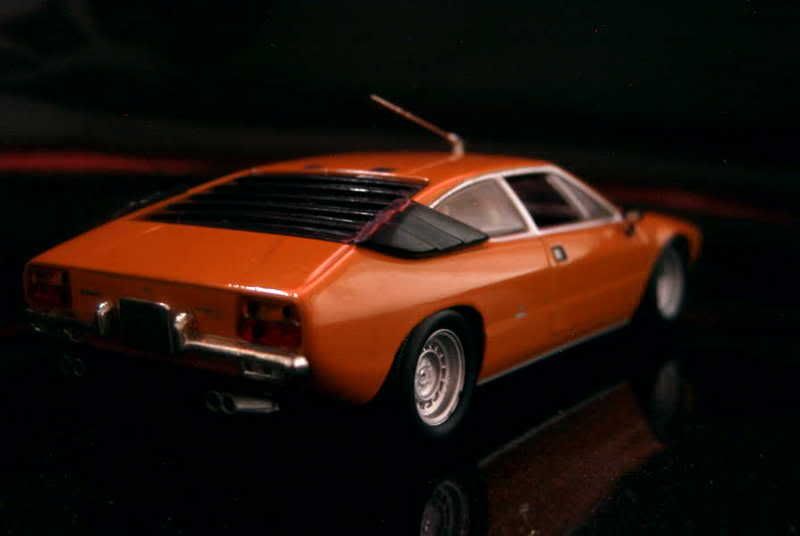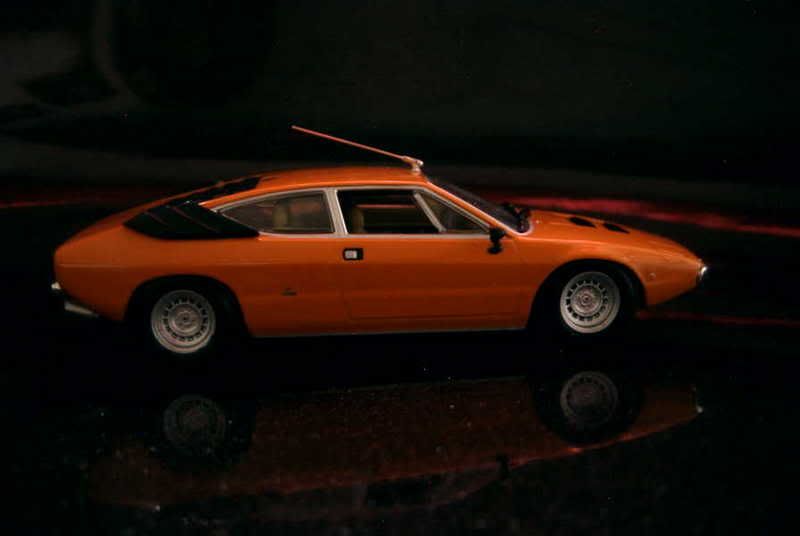A little history
Willing to fight Ferrari head-on as we have already seen, Ferruccio Lamborghini decided that his own company should build a challenger to the smaller and more affordable Dino. His decision was made all the more clever by the fact that his other rival Maserati was simultaneously studying its own “bargain” sports car, the Merak, a 2+2 coupe which was to share many parts with the Citroën SM. Suddenly, the lower end of the GT market was to become rather crowded.
Lamborghini readied its Urraco for the 1970 Turin motor show – that is, readied the car for being unveiled, as this first Urraco was found wanting in development and, ultimately, production didn’t start before 1973, after the Merak had hit the market and, unknown from Lamborghini at the time, only weeks away from the oil crisis that would affect all automobile companies, but none more than the likes of the Sant’Agata manufacturer. It should be noted that despite this protracted preparation, the first tens of cars delivered didn’t totally adopt the final production specs…
Smaller than the rest of its siblings, the Urraco was new from the ground up. Engine was a 2.5-litre V8, all made in alloy and good for 220 hp. It was mounted transversally amidships, right behind the two small rear seats. This placing allowed to maintain a small space for luggage at the extreme rear. A sign that the car was meant more for comfortable high-speed highway travels than genuine performance was probably its standard air-conditioning system. On the outside, the Urraco came as a splendid fastback coupe that had been unsurprisingly penned by Bertone’s star designer Marcello Gandini.
Despite all of the Urraco’s qualities, sales were disappointing due to the aforementioned reasons. During the 1974 Turin motor show, Lamborghini reacted by adding two new variants to its original model (named P250 with regards to its engine’s size): the P200, a smaller 2.0-litre, 182 hp car aimed at the Italian market where heavy taxes hit vehicles displacing more than 2000cc; and the P300, which enjoyed a reworked 3.0-litre V8 good for 250 hp.
During the same 1974 Turin venue, Bertone had presented a striking Bravo prototype based on a shortened Urraco platform. The car was strictly a concept car but, one year and a half later during the 1976 Geneva motor show, Bertone unveiled a much more realistic Silhouette, basically a two-seat targa version of the Urraco. Adopted by Sant’Agata as its first production open car, the Silhouette was powered by the larger 3.0-litre engine, and its ambitions were made clear by a much more aggressive body that hinted at the new Countach.
Nevertheless, by the late Seventies Lamborghini was in turmoil. All the financial resources of the company had been wasted in the difficult development of a large four-wheel-drive vehicle, the Cheetah that was supposed to seduce both the military and the Middle East princes. No one bought it, bringing Lamborghini to the brink of bankruptcy, and it’s a meagre relief for the small manufacturer to think its original concept was finally made a success by others than itself as the Hummer. In these difficult times, some models had to go and, as the sales of the Urraco and Silhouette had always been below expectations, they unsurprisingly departed Lamborghini’s range in 1979.
The company seemingly headed for a slow agony when new investors, reckoning its potential, saved it by injecting generous amounts of cash into its coffers. With this the Silhouette was unexpectedly revived as the Jalpa. Launched in 1981 as a cheaper alternative to the Countach, the “new” car had lost its predecessor’s targa top, but won a larger 3.5-litre, 255 hp V8, thanks to which a 234 kph top speed could be promised. Though the car was based on a rather old platform, the times were not as harsh in the Eighties as they had been for GTs during the previous decade. The Jalpa sold in fair numbers until the company was sold to Chrysler. One of the American giant’s first decisions regarding its new acquisition was to suspend the production of the Jalpa, for not being prestigious enough. During a fifteen-year career, less than 1,300 Urracos and derivatives had been produced.
About the model
Model: Lamborghini Urraco
Year: 1974
Maker: Minichamps
Scale: 1/43
Distributed by: Minichamps, limited edition - 4,512 pieces
Acquired: brand new, in September 2007, in Manila, Philippines
Minichamps proposes a disappointing model of the initial Urraco. The die-cast looks heavy and much too low when compared to the real car, while details as the thick wipers, equally fat radio antenna and large black side scoops don’t help. The German brand’s reputation won’t prevent this beer-bellied model receiving a 8/20.


Willing to fight Ferrari head-on as we have already seen, Ferruccio Lamborghini decided that his own company should build a challenger to the smaller and more affordable Dino. His decision was made all the more clever by the fact that his other rival Maserati was simultaneously studying its own “bargain” sports car, the Merak, a 2+2 coupe which was to share many parts with the Citroën SM. Suddenly, the lower end of the GT market was to become rather crowded.
Lamborghini readied its Urraco for the 1970 Turin motor show – that is, readied the car for being unveiled, as this first Urraco was found wanting in development and, ultimately, production didn’t start before 1973, after the Merak had hit the market and, unknown from Lamborghini at the time, only weeks away from the oil crisis that would affect all automobile companies, but none more than the likes of the Sant’Agata manufacturer. It should be noted that despite this protracted preparation, the first tens of cars delivered didn’t totally adopt the final production specs…
Smaller than the rest of its siblings, the Urraco was new from the ground up. Engine was a 2.5-litre V8, all made in alloy and good for 220 hp. It was mounted transversally amidships, right behind the two small rear seats. This placing allowed to maintain a small space for luggage at the extreme rear. A sign that the car was meant more for comfortable high-speed highway travels than genuine performance was probably its standard air-conditioning system. On the outside, the Urraco came as a splendid fastback coupe that had been unsurprisingly penned by Bertone’s star designer Marcello Gandini.
Despite all of the Urraco’s qualities, sales were disappointing due to the aforementioned reasons. During the 1974 Turin motor show, Lamborghini reacted by adding two new variants to its original model (named P250 with regards to its engine’s size): the P200, a smaller 2.0-litre, 182 hp car aimed at the Italian market where heavy taxes hit vehicles displacing more than 2000cc; and the P300, which enjoyed a reworked 3.0-litre V8 good for 250 hp.
During the same 1974 Turin venue, Bertone had presented a striking Bravo prototype based on a shortened Urraco platform. The car was strictly a concept car but, one year and a half later during the 1976 Geneva motor show, Bertone unveiled a much more realistic Silhouette, basically a two-seat targa version of the Urraco. Adopted by Sant’Agata as its first production open car, the Silhouette was powered by the larger 3.0-litre engine, and its ambitions were made clear by a much more aggressive body that hinted at the new Countach.
Nevertheless, by the late Seventies Lamborghini was in turmoil. All the financial resources of the company had been wasted in the difficult development of a large four-wheel-drive vehicle, the Cheetah that was supposed to seduce both the military and the Middle East princes. No one bought it, bringing Lamborghini to the brink of bankruptcy, and it’s a meagre relief for the small manufacturer to think its original concept was finally made a success by others than itself as the Hummer. In these difficult times, some models had to go and, as the sales of the Urraco and Silhouette had always been below expectations, they unsurprisingly departed Lamborghini’s range in 1979.
The company seemingly headed for a slow agony when new investors, reckoning its potential, saved it by injecting generous amounts of cash into its coffers. With this the Silhouette was unexpectedly revived as the Jalpa. Launched in 1981 as a cheaper alternative to the Countach, the “new” car had lost its predecessor’s targa top, but won a larger 3.5-litre, 255 hp V8, thanks to which a 234 kph top speed could be promised. Though the car was based on a rather old platform, the times were not as harsh in the Eighties as they had been for GTs during the previous decade. The Jalpa sold in fair numbers until the company was sold to Chrysler. One of the American giant’s first decisions regarding its new acquisition was to suspend the production of the Jalpa, for not being prestigious enough. During a fifteen-year career, less than 1,300 Urracos and derivatives had been produced.
About the model
Model: Lamborghini Urraco
Year: 1974
Maker: Minichamps
Scale: 1/43
Distributed by: Minichamps, limited edition - 4,512 pieces
Acquired: brand new, in September 2007, in Manila, Philippines
Minichamps proposes a disappointing model of the initial Urraco. The die-cast looks heavy and much too low when compared to the real car, while details as the thick wipers, equally fat radio antenna and large black side scoops don’t help. The German brand’s reputation won’t prevent this beer-bellied model receiving a 8/20.





4 comments:
classic Lamborghinis and Ferraris are always my favorite, they grow old with style and finesse! :-) this is a great model in 43 scale specially when Minichamp is behind it! :-)
Thanks Mike for your comments! Ah, classic Ferraris and Lamborghinis... though as I already mentioned, I prefer Maseratis, but I have to admit that I don't like to do anything as everyone else... :lol:
hi amigo, I love this car since I met it at a car exhibition in my country when I was almost a boy.
I agree with the minichamps massive look.
there is an ixo/altaya model that looks a little better, and costs half the price.
as usual, the history is very nice to read and enjoy.
Good to know Ixo did better - and cheaper obviously - than Minichamps on this one. Every other time they've tried to mimick the Italian GTs of the German manufacturer, they were clearly one notch below. Have you already read my post about the Maserati Ghibli? This one allowed me a direct comparition between the two brands.
Post a Comment